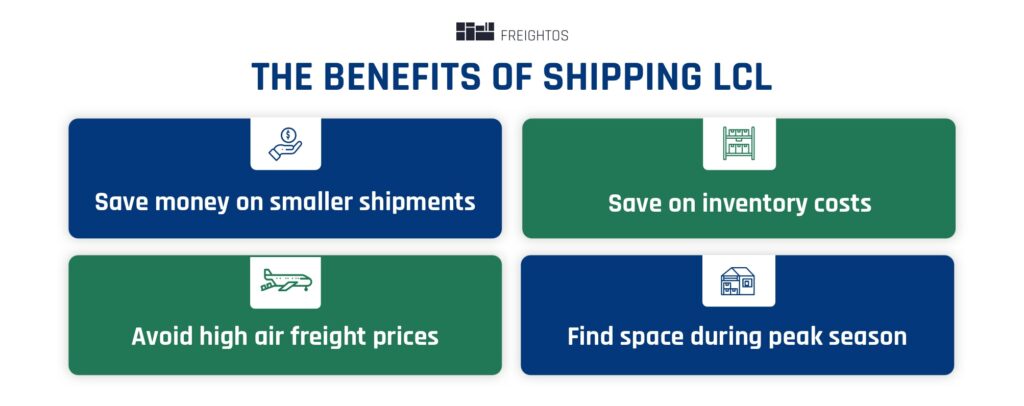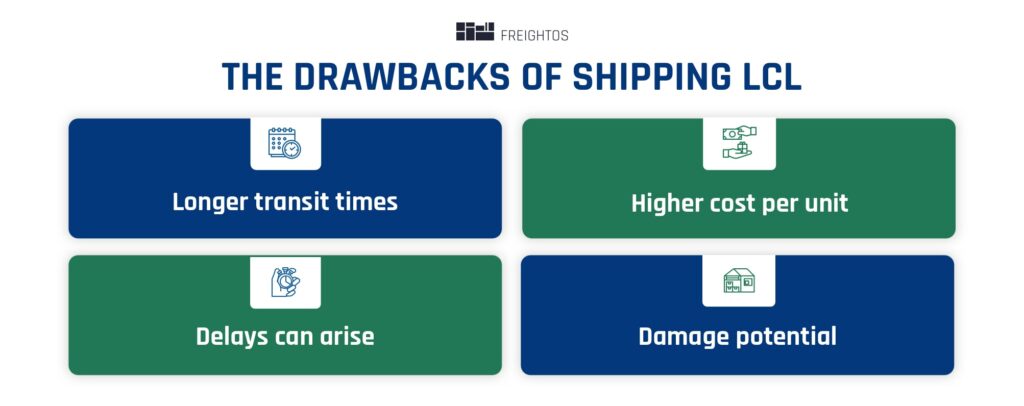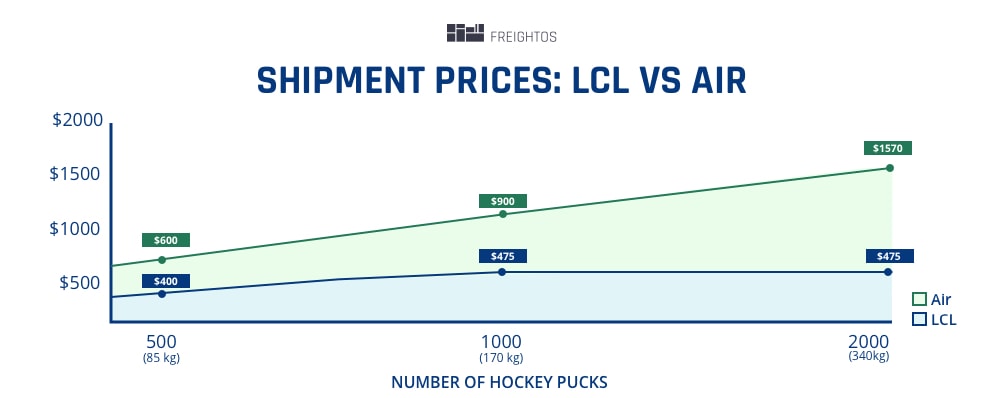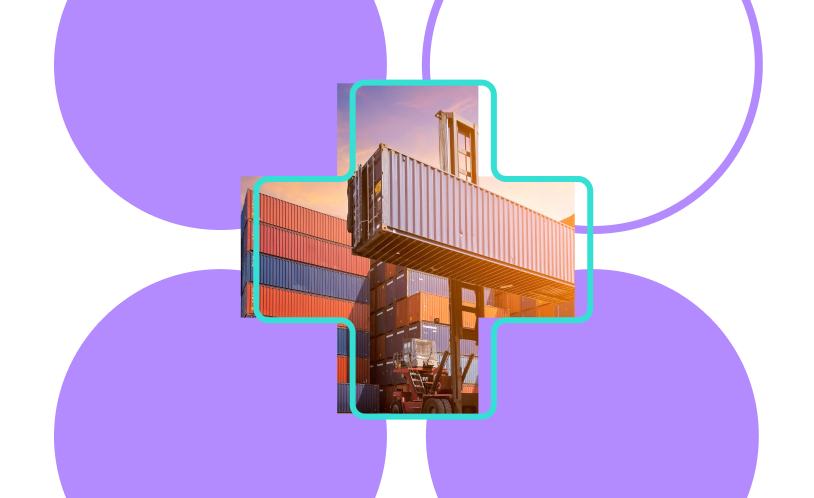There comes a point in every shipper’s life when they start daydreaming about container interior dimensions and consolidation centers.
Well, maybe not daydreaming. But at least realizing that it’s time to decide if LCL shipping is right for them.
If you have smaller freight shipments, take a look at this guide to learn all about LCL shipping. This guide will cover what it costs, how long it takes, how LCL compares to other modes, and more.
You’re one step closer to getting your goods moving.
LCL Shipping Quote
With Freightos, you have the power to access an instant LCL (Less than Container Load) shipping quote. Utilize the Freight Rate calculator below to calculate your LCL shipping costs in seconds!
Looking for live quotes from vetted providers?
LCL Shipping Costs
LCL cost is calculated primarily by volume, usually in cubic meters (CBM). The more space you need, the more you pay.
Weight is also taken into account when determining LCL shipping costs, but because container ships can handle huge amounts of weight, volume usually matters more to overall costs.
LCL price Quotes from freight forwarders include the following:

Pickup: The cost of picking up your shipment from the warehouse or factory.
Origin: LCL shipments need to be loaded onto containers along with other shipments, or consolidated, at a Container Freight Station, or CFS. This is sometimes referred to as container stuffing.
Main leg: The cost of the sea journey. Although this is the main leg of the shipment, it may not be the most expensive part. In certain instances, charges at the CFS can be very significant because they require significant machine and manpower.
Destination: At arrival in the destination country, LCL shipments need to stop at a CFS for deconsolidation, or unstuffing.
Delivery: The cost of trucking your goods to the destination warehouse.
What is LCL shipping?
LCL stands for less than a container load and describes sea shipping for cargo loads not large enough to fill a full 20ft or 40ft shipping container.
Since LCL shipments fill less than a full 20ft or 40ft shipping container, these are grouped with other cargo. This is why LCL shipments are sometimes called groupage shipments.
What is a loose cargo load?
A loose cargo load, while sometimes confused with LCL, is a load that is not palletized. This term can apply to shipments that do not require palletization and/or cannot be containerized due to their dimensions.
Sometimes loose cargo is used to describe goods that simply have not been palletized yet. Almost all carriers require palletization of goods to avoid damage and allow for smoother loading and unloading.
The benefits and drawbacks of shipping LCL:
- When you ship LCL, you pay only for the volume you need – not a flat rate as with FCL.
- Shipping fewer goods more frequently means spending less on inventory warehousing space.
- LCL is cheaper than air freight, so if you have some spare time to wait for your shipment, you can lower shipping costs.
- When container capacity is limited, for example during peak shipping season or during other periods of high shipping volume, LCL can be easier to find and faster than FCL.

Of course, no shipping solution is perfect. Here are the main drawbacks to LCL shipping:
- LCL shipments need to be loaded and unloaded from containers, which adds a few days to the journey.
- LCL shipments are more expensive per cubic meter than FCL – sometimes even twice as much.
- Other shipments’ customs delays may cause your goods to be delayed along with them.
- LCL goods are handled more, which increases the chances of damage or loss.

Looking for freight rates from vetted providers?
LCL or Air Cargo: Shipping Rates
This is a question we often get from from importers and exporters: If you have a small shipment, should you ship by LCL or air?
The answer is that it largely depends on how quickly you need your goods – and how much you’re willing to pay.
Let’s say you’re shipping 500 hockey pucks from Shanghai to Los Angeles (that’s approximately 0.06 CBM and 85 kg in case you were wondering).
These aren’t accurate rates, but let’s say that if you ship the hockey pucks by LCL, it costs about $400 and by air, it’s $600.
Now let’s double it to 1,000 hockey pucks. LCL is now $475, but air has jumped to $900.
Doubled again, 2,000 hockey pucks is still $475 on LCL, but air is all the way up to $1,570.

As shipment size and weight increase, air rates rise dramatically faster than LCL rates. Increases in weight are even more impactful.
On the other hand, an air shipment is much faster: in this example, your shipment would take 7-9 days by air, and 25-30 days by LCL. Again, these are not exact transit time but are illustrative of the differences between air cargo and LCL shipping.
Here are a few tips for choosing between air and LCL:
- When you ship LCL, you will be charged for a minimum of 1 CBM. That means if you have a shipment smaller than that, you won’t get a lower price.
- Air and LCL costs are both calculated by both weight and volume. But for air, weight is the more important factor – that is, relatively small weight increases mean much higher prices. On the other hand, for LCL, space makes a bigger difference than weight. Bottom line: LCL will be much cheaper for heavier goods.
- Air freight prices and transit times do not vary much based on the destination city. For example, air freight from Shanghai to Los Angeles will be roughly the same in cost and time as air freight from Shanghai to New York. However, for LCL, this difference in distance will increase both cost and transit time.
LCL or FCL
LCL is great for small loads, but sometimes it’s worth paying for a full container even if you don’t have enough to fill it.
Why?
Because LCL costs more per CBM than FCL. So once a shipment hits a certain volume, an entire container could be the better choice. For a slightly higher price, you’ll get the benefits of shipping FCL, including faster transit time and lower chances of damage.
One caveat: if you’re shipping to an Amazon warehouse, it’s often easier to get an appointment to drop off LCL shipments. So even if you save money by shipping FCL, you might end up with extra demurrage and detention charges due to warehouse appointment delays.
So what’s the tipping point?
It depends on your shipment’s dimensions, but generally speaking, once volume hits around 10 CBM, you might start to consider FCL.
Additional LCL Fees
Labeling and Palletization for Amazon Shippers
If you are shipping your goods to an Amazon FBA warehouse, you will need to have them labeled and palletized according to Amazon’s requirements.
Having your factory label your boxes is the most efficient option, and generally, palletizing at the factory is cheaper than at the consolidation center. However, before having your supplier palletize, make sure they’re familiar with Amazon’s standards and requirements so you don’t get charged extra LCL fees.
Customs Bonds
Any time you import to the US, you’ll need to set up a customs bond, which is essentially insurance for Customs and Border Patrol in the event your company does not pay.
If you ship infrequently, choose a singly-entry bond. For frequent shippers, an annual bond will likely be worth it.
Duties and Taxes
Duties and taxes are calculated by Customs and Border Patrol when your goods arrive at port, but you can estimate in advance how much you will owe and calculate your LCL fees more accurately.
What paperwork do I need for my LCL shipment?
For the rundown on all the paperwork you’ll need to ship LCL, head on over to our key freight documents guide.
How long does LCL shipping take?
Sea shipping generally takes approximately 6-10 weeks, depending on your origin and destination. LCL tends to take slightly longer than FCL due to consolidation and deconsolidation.
Expert tips for getting the best LCL shipping rates
1. Request quotes from multiple freight forwarders.
Having multiple quotes will not only allow you to choose the best price. It will also give you insight into market rates and help you better understand LCL shipping rates and charges. That is, sometimes you’ll get a quote that is way above or below market LCL shipping rates – but you won’t know unless you have a range of quotes to compare.
2. Don’t forget to take pallet dimensions into account.
Suppliers always provide box dimensions for your goods, but make sure to also request dimensions including pallets. Pallets take up container space – space you’ll be charged for.
3. Remember that fragile goods might need more space, and therefore cost more.
In most LCL shipments, pallets are stacked in order to maximize container space. But if you’re shipping flatscreen TVs, you won’t want anything stacked on top of them. That means costs will be higher because your shipment leaves less room in the container for other packages.
4. Avoid hidden LCL charges and fees by booking port-to-door or door-to-door service with your freight forwarder.
The day might come when you get an LCL quote that seems impossibly cheap. What could be bad about that?
Well, it could turn out that LCL charges you thought were included were in fact not part of the quote.
To prevent this, Sandeep Bhalotia, CEO of logistics provider PlanYourCargo, recommends booking port-to-door or door-to-door service for LCL. “You might get a discount at the origin, but if service to the door is not included, the discount might be offset with high charges at the destination,” he explains. “A quote that includes service to your door means all charges are validated in advance.”
5. Understand the interior dimensions of the container.
A 20ft container is not actually 20 feet – at least not from the inside. Make sure you know containers’ interior dimensions to understand how much container space you really need – and help decide if LCL or FCL is right for you.
6. If you’re an Amazon FBA shipper, know your warehouse guidelines.
Amazon FBA has strict warehouse guidelines and these sometimes change. If you know what the requirements are, you can often arrange to have your supplier take care of them, which saves you money down the line.
LCL Freight: How to ship LCL cargo on Freightos.com
If you choose to book your LCL cargo shipment on Freightos.com, we’ll take care of a lot of the confusing and time-consuming details. For example:
- When you enter your LCL freight shipment volume and weight on the platform, our tool will send you a message if it’s worth considering FCL.
- Because Freightos.com is a marketplace, you’ll be able to choose from a variety of Quotes in real time. No need for phone tag – and you’ll understand freight market rates at a glance.
- We offer you insurance and customs solutions while you book your shipment.
- You’ll be able to track your LCL freight shipment right on the Freightos.com platform and communicate with your freight forwarder throughout your shipment’s journey.
Looking for live quotes from vetted providers?
Watch the full LCL webinar
Prefer to get your LCL info video-style? You’re in luck.
Watch our full LCL webinar right here:


